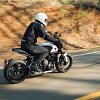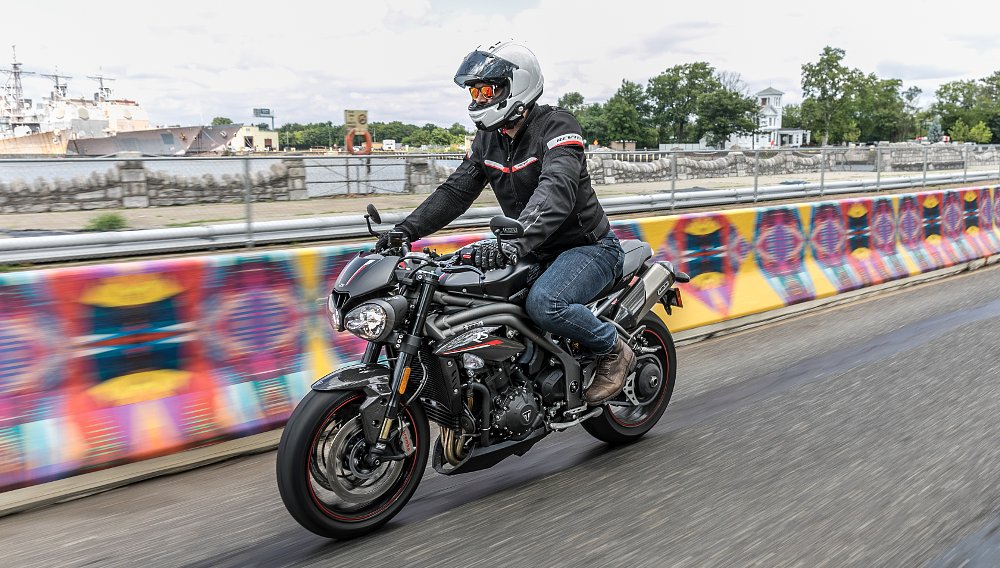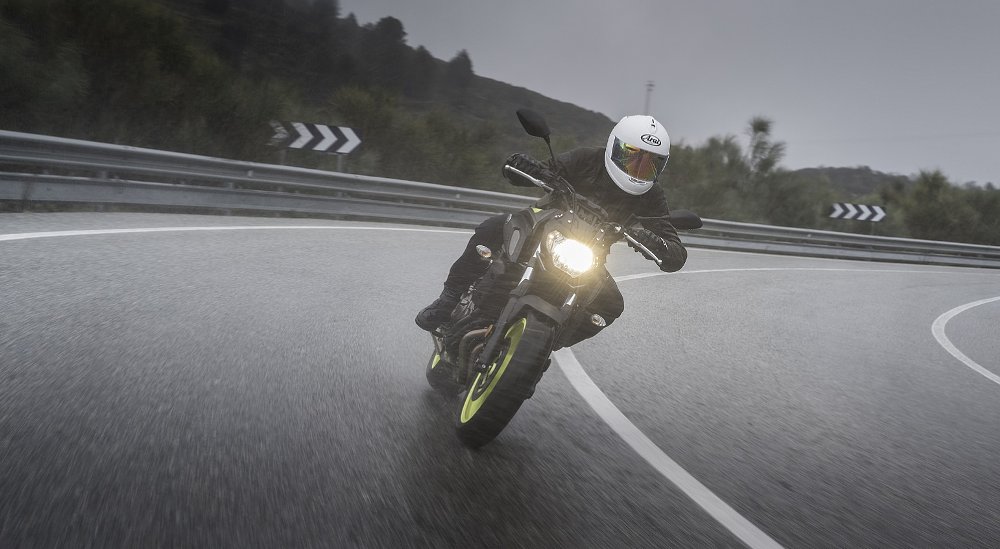From 2011 to 2013 I worked at Castle Powersports in Nashville, Tennessee. On Sundays, when the dealership was closed, my boss would let me have my pick of the used bikes on the floor to take out for a ride. So on Saturday nights I’d wheel out whatever model had piqued my interest that week and hit the road.
For really special bikes, I’d pack an overnight bag and head east to the mountains of North Carolina and northern Georgia. I’d crash at a cheap hotel, wake up early, and spend all day Sunday riding some of the best sport roads in the country. It was here that I first rode both the Triumph Street and Speed Triples. So when the opportunity to ride the new Triumph Trident came across my desk, I found it only fitting to revisit these same mountain roads where I rode its older siblings years before.
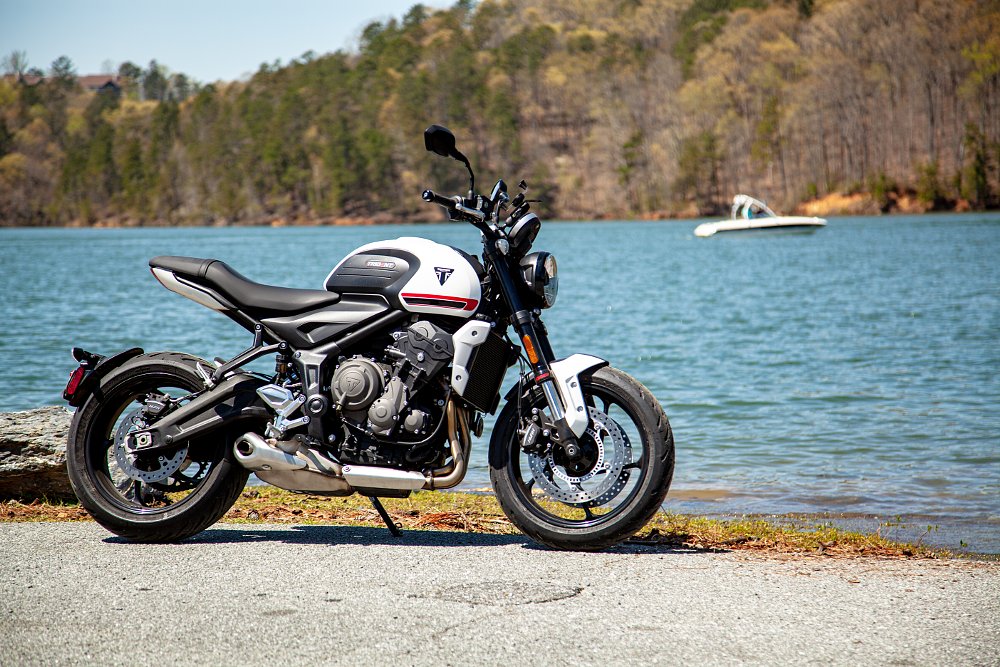
Triumph Trident
New for 2021, the Trident represents the entry point to Triumph’s line of naked sport bikes. At $8,095, it’s about $2,700 less than the Street Triple R, $4,700 less than the Street Triple RS, and more than $10,000 less than the new Speed Triple RS. In fact, it's now the most affordable bike in their entire U.S. line.
The Trident is powered by a 660 cc inline-triple engine that’s derived from the 675 cc triple that was first introduced in the Triumph Daytona back in 2006. This new engine, however, isn’t nearly as high strung as the Daytona’s. It actually has more in common with the retuned version of the 675 that made less top end power and was used in the Street Triple starting in 2008. The Trident’s engine is even more subdued.
This 660 cc triple makes a claimed 80 horsepower at 10,250 rpm and 47 foot-pounds of torque at 6,250 rpm. Power is broad and the torque can be felt across the entire rev range. It’s paired with a six-speed gearbox and a slipper-assist clutch.
Input to the engine is provided via a throttle-by-wire system that allows for two ride modes, Rain and Road. Rain mode has a less aggressive throttle response and increased sensitivity from the Trident’s traction control system, whereas Road mode features a more responsive throttle and less intervention from traction control. For those of you who like to lift the front wheel a bit, the traction control system can be disabled via the TFT dash.
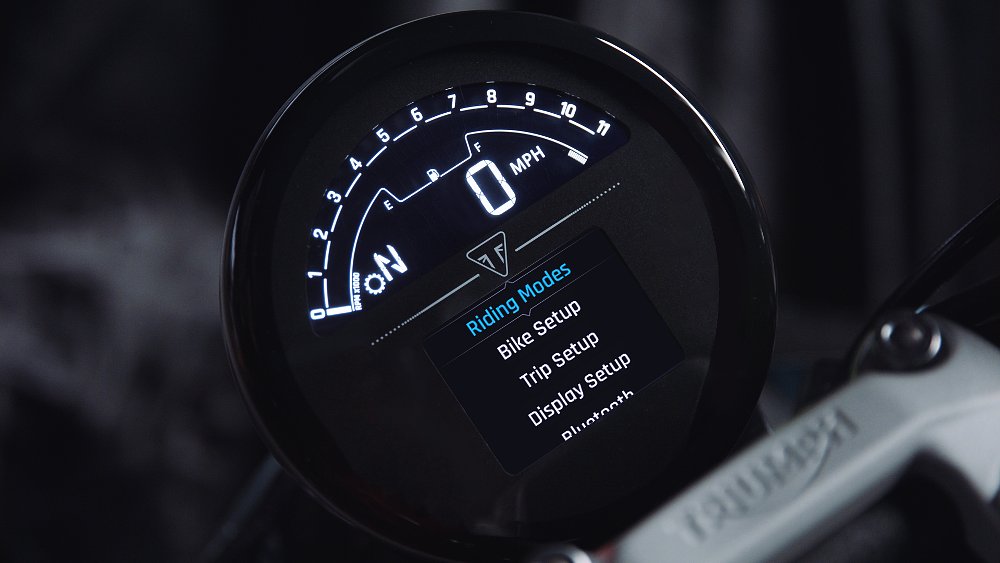
The dash layout is clear and easier to read and control than some of the more expensive and complex units in Triumph’s line. You can scroll through your options using the arrows at your left hand and the little check button to make a selection. Using the dash, you can swap rider modes, disable traction control, dim or brighten the dash (extremely useful for night riding), link your phone for turn-by-turn navigation or control your music, control your GoPro camera, or program the turn signals to operate the way you’d like. I liked the setting where you hit the button once and the directional light flashes three times and then stops.
Slowing down the Trident are a pair of Nissin two-piston sliding calipers clamping down on 310 mm discs on the front wheel. Rear-wheel duties are covered by a single-piston sliding Nissin caliper and a single 255 mm disc. ABS is standard and features a relatively smooth action when it does kick in.
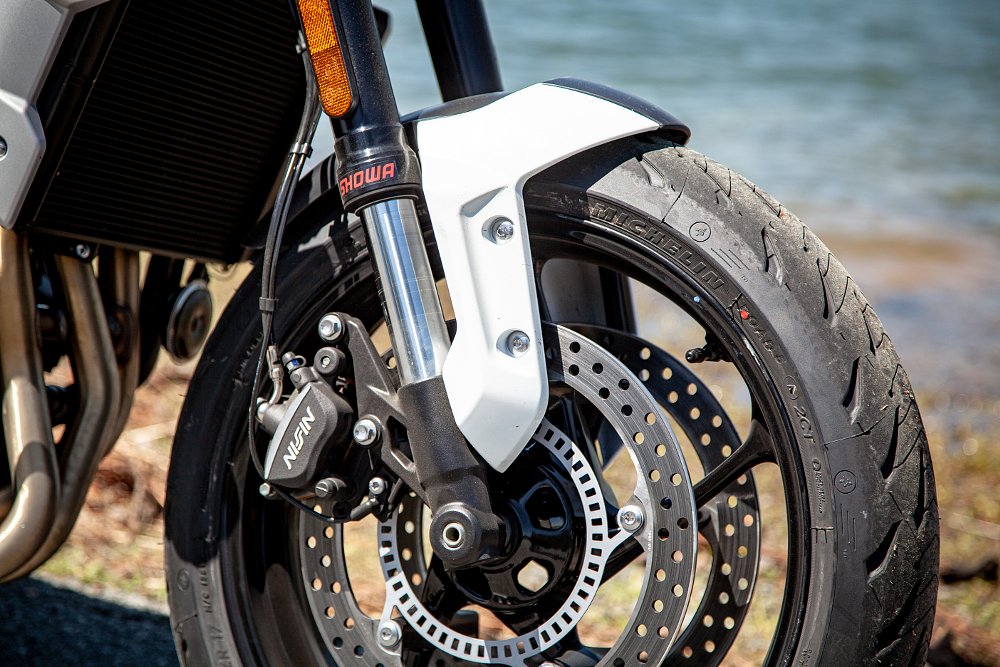
The Showa suspension is a bit more impressive than you might gather from a quick glance at the spec sheet. The 41 mm inverted fork has no adjustability but does feature Showa’s “Separate Function” technology. This splits the compression and rebound damping duties so each is isolated to an independent fork leg. The rear monoshock features a linkage mount as well as a five-position preload collar.
Geometry is more relaxed than its more aggressive older sibling. Rake is 24.6 degrees and trail is 4.22 inches. Compare that to the Street Triple R with its steeper 23.5 degrees of rake and 3.87 inches of trail and the Trident has a more relaxed feel, requiring a bit more input to roll it through a corner, but with more stability overall.

The seat height is a very approachable 31.7 inches, which is reminiscent of the original Street Triple’s 31.5-inch seat. This provides an easier reach to the ground for shorter riders yet is still comfortable enough to fit this six-foot, three-inch rider.
The Trident is wearing the impressively fantastic Michelin Road 5 tires. This is a great all-around street tire that sticks well to the asphalt in a variety of weather conditions and provides plenty of confidence.
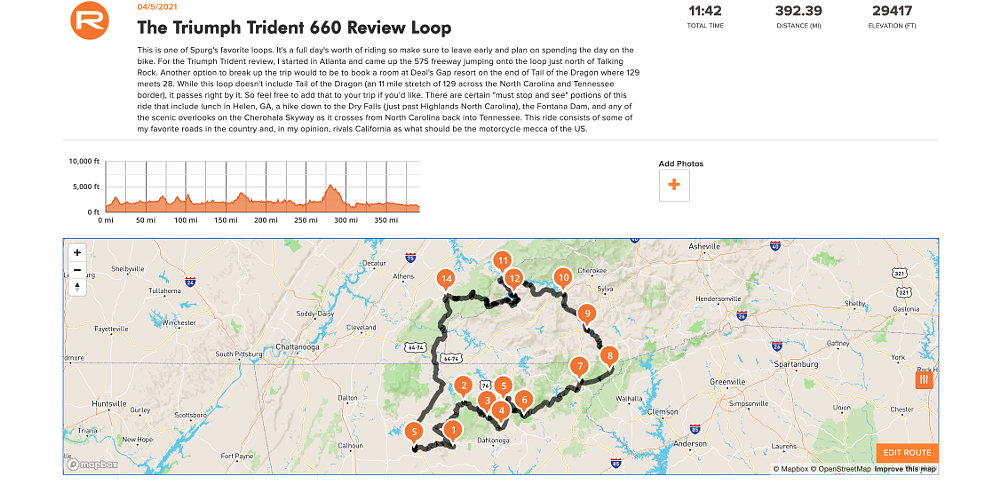
Riding the Triumph Trident
I mapped out the same loop I used to tackle on my weekend rides back in my Tennessee days. You can jump in at various points and either ride it all in one long day like I’ve written about with my old Honda VFR800 or you can split it up over two days for a more scenic approach. Because we were also filming a short video for this review, I split the loop into a few sections and mainly focused on Georgia roads to accommodate the filming. But I started with a quick ride around Atlanta before heading up Highway 575 to Talking Rock, Georgia.
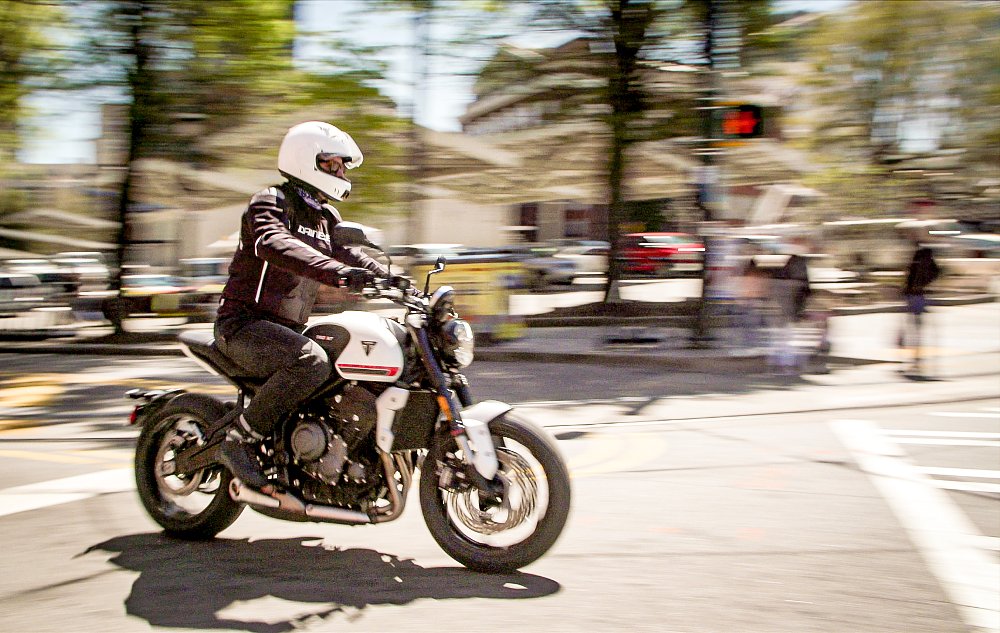
Commuting around town, I was surprised by how crowded Atlanta feels these days. I haven’t been to town since I flew in to pick up a Street Twin back in 2016 and it just feels much busier. The Trident was much more comfortable dealing with the stop-and-go city conditions than I remember the Street Triple RS being when I reviewed that bike in Philadelphia. While the Street Triple just feels high-strung and impatient in the city, the Trident was content just meandering down crowded streets.
The mellow side of the 660 engine just chugs along calmly and quietly below 5,000 rpm. The suspension is surprisingly plush and seems comfortable handling the average pothole or bump in the road. The seating position is more relaxed and upright than I was expecting with a handlebar that seems to have a bit more sweep and height than I remember finding on the Street Triple. The only downside I found with this bike around town was with the clutch lever.
At first I thought the transmission was just not as refined as other Triumphs I’ve ridden. Shifts resulted in more of a “clunk” than a smooth “snip.” Then I realized that if I pulled the lever all the way in, nearly to the handlebar, it shifted seamlessly.
I prefer to use my index and middle finger to operate the clutch while leaving my ring and pinky fingers wrapped around the handlebar. I talked about this recently in my Chief review and it sounded like there was a little bit of confusion around this style of clutching. I prefer this approach as it allows me to maintain more control and stability while shifting than the ol’ hamfisted four-finger approach.
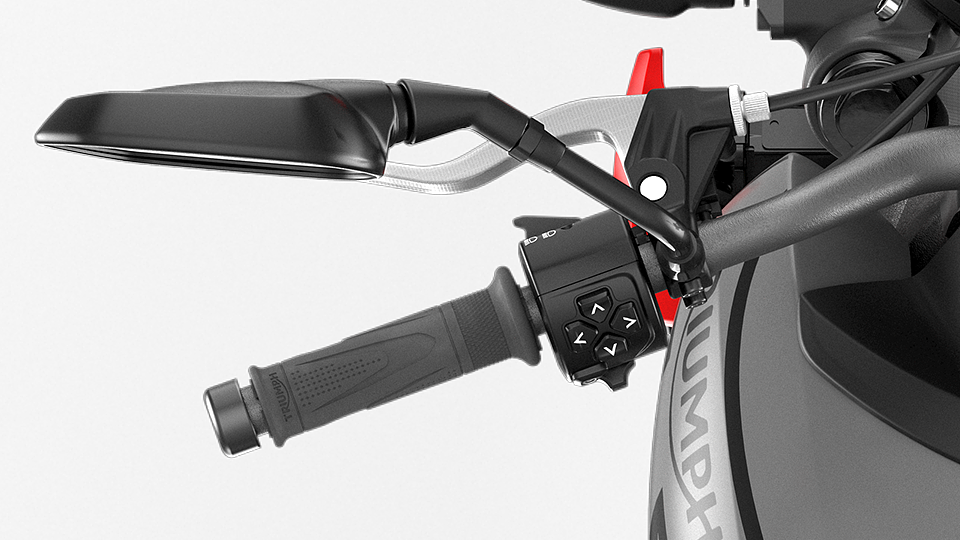
The problem I was having was that the clutch lever was hitting my fingers before it was engaged far enough for smooth shifting. I made some adjustments to the clutch cable and that helped, but even then it was nearly impossible to get the Trident into neutral without pulling the clutch in all the way.
Ideally, I wish the clutch lever was adjustable in the same way the brake lever is. But that’s a simple fix in the aftermarket world. What I was more excited to learn is that Triumph has a quickshifter upgrade for the Trident. Given the price of the bike, I can understand why it’s not a standard option, but I think it’s great that Triumph gives you the option to add this for more sporty rides.
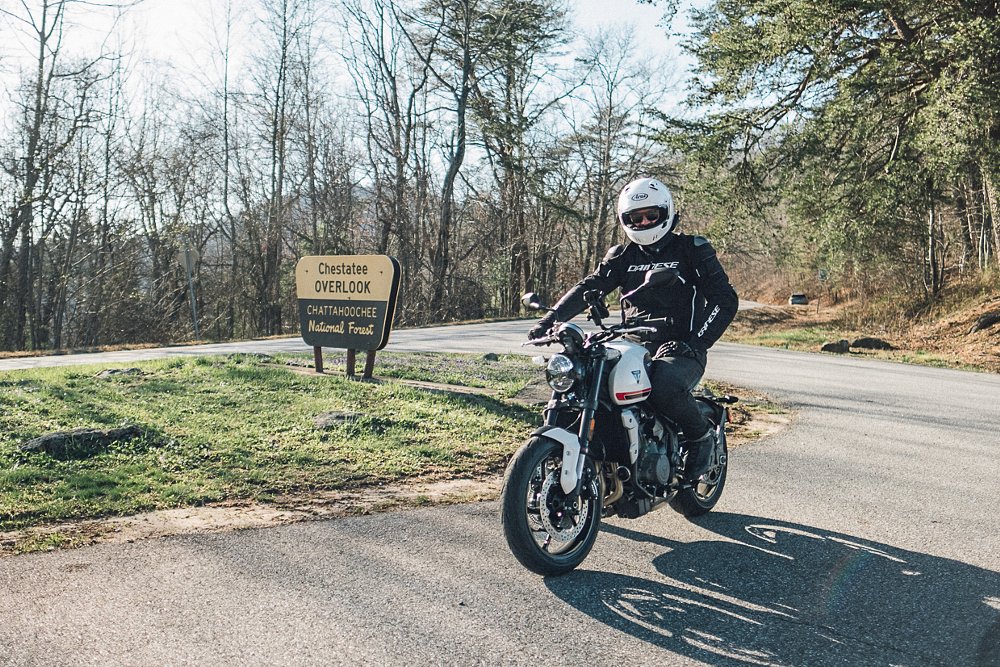
Heading north I spent the rest of my time with the Trident riding mountain roads through the Chattahoochee and Nantahala National Forests.
The Trident does as good on the highway as any other naked bike I’ve ridden. There is no wind protection, so you’re just taking it all in the face. But it felt stable and planted at highway speed. It held a perfectly calm 80 mph and I was impressed with how incredibly smooth and well mannered this engine is.
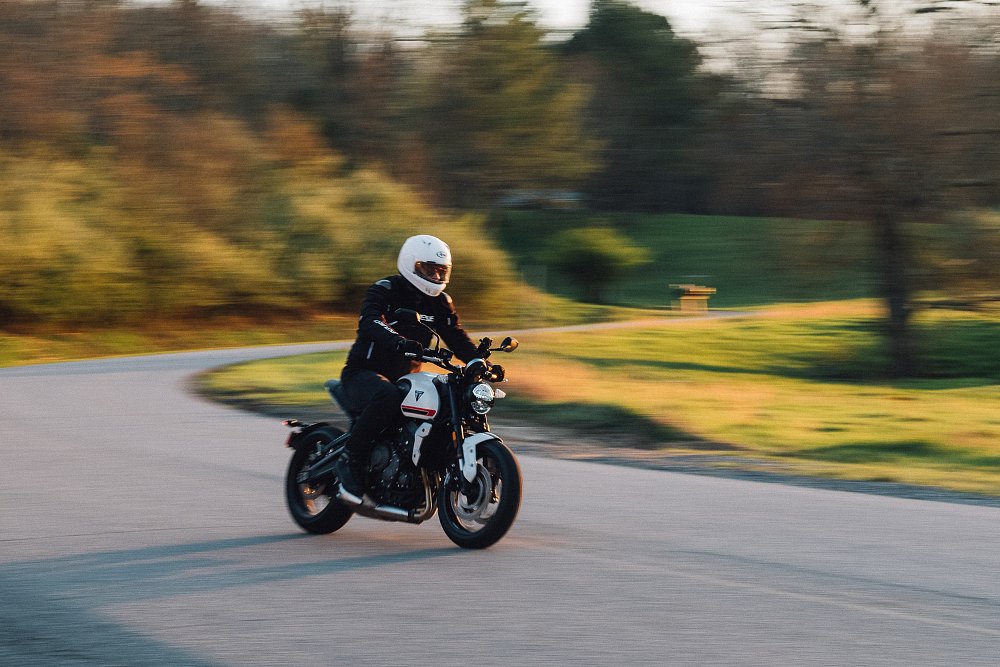
I started the day warming up on some of the gentle sweeping roads leaving Talking Rock and riding east. It took me a little while to get used to being back on a sporty standard with 17-inch wheels and good tires. All of the bikes in my garage currently have 21-inch front wheels with tires that are not at all confidence-inspiring at full tilt on asphalt.
For as plush as the Showa suspension felt in the city, it fared well on the increasingly snake-like mountain roads of northern Georgia. I am currently 220 pounds and I spent some time playing around with the rear shock’s preload collar to find that the fourth setting is what worked best for me.
I know exactly how much I weigh because I stumbled upon an industrial scale in the train yard down in Atlanta. According to Norfolk Southern, the Triumph Trident weighs in at 420 pounds with three-quarters of a tank of gas. That’s pretty much spot on with Triumph’s claims of a 417-pound wet weight and it puts it smack dab in the middle of other bikes in the segment.
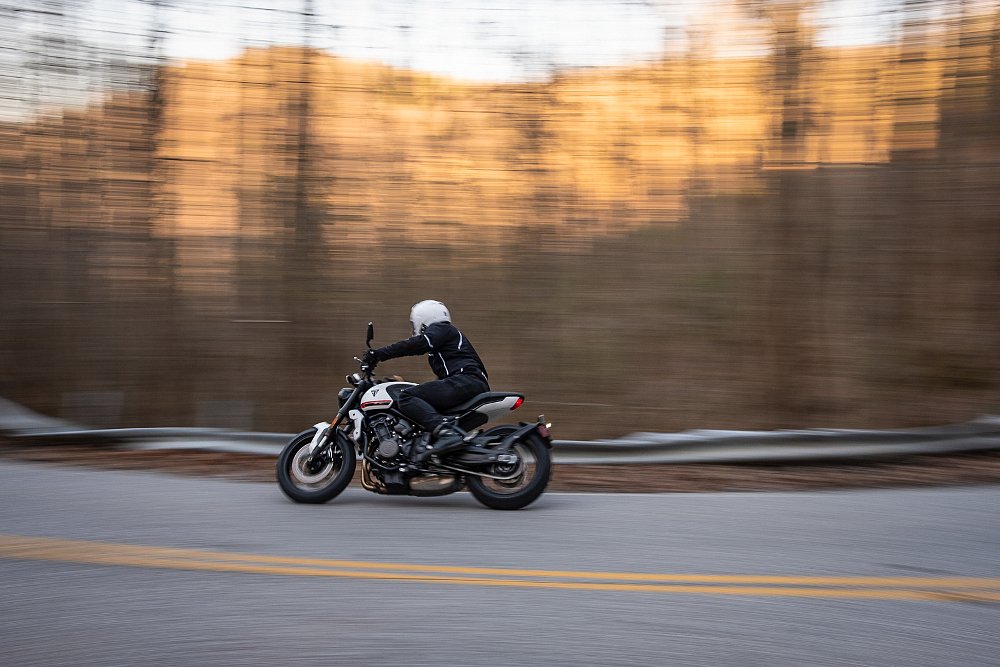
Between the competent suspension and the light weight, the Trident handled sport riding duties well. That being said, the slightly relaxed geometry meant it required a bit more input on the bars and a leveraging of my body weight to get it to do what I wanted. While there is a lot of fun to be had, it’s not as sharp as the Street Triple.
The engine, however, packed just as much fun for a ride down a windy mountain road as anything else in Triumph’s line. While the engine has decent grunt throughout its entire rev range, it really comes alive around 5,000 rpm and pulls strong all the way up to the 10,250 rpm redline. I found myself using mostly third and fourth gear, cruising around 5,500 rpm, and rolling power on from there. What the engine lacks in top-end horsepower, it makes up for in character.
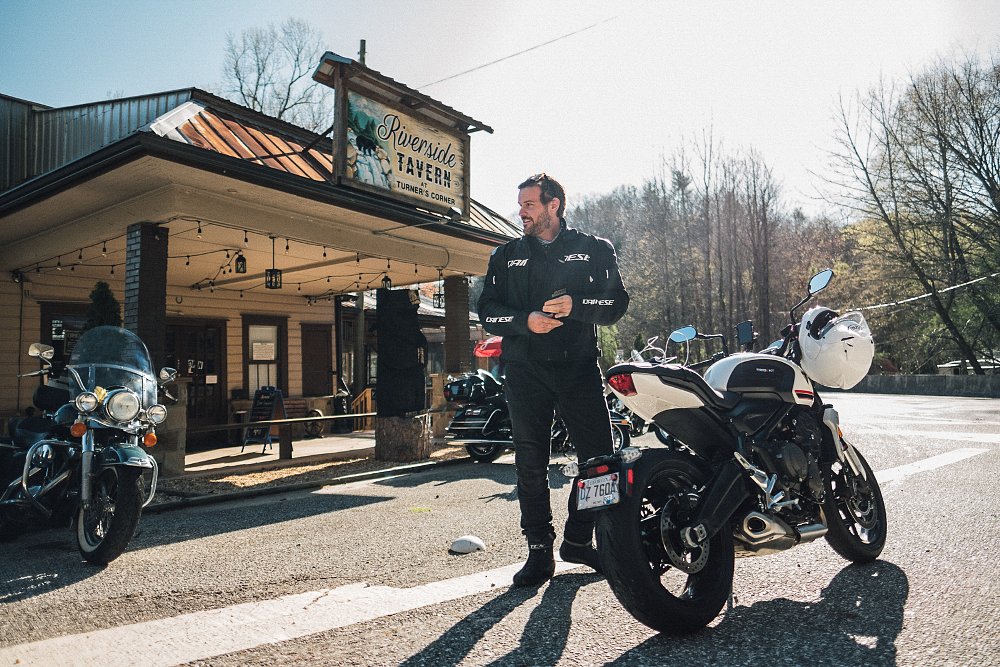
Rolling into Helen, Georgia it occurred to me that on all of my previous trips I had arrived during the middle of the week. Helen, as it turns out, is quite the tourist trap on the weekends. Encountering a very crowded Main Street, I opted to flip a U-turn and head back down the road to the Riverside Tavern at Turner’s Corner. And I was glad I did.
It turned out to be a low-key spot with a bunch of fun motorcycles parked out front. I saw an old Kawi W650, a Ducati 999, as well as a Triumph Street Twin with a huge Windjammer-esque fairing bolted up to the front. And that doesn’t count the dozens of other bikes I saw roll by while munching on red pepper crusted avocado bites.

Speaking of lunch, I swear I’ve been losing the COVID weight and actually doing a good job of sticking to a diet. That being said, scrolling back through the photos, I look ridiculously huge on this bike. While I felt comfortable on it and didn’t have any issues, I’d think twice before sticking a passenger on the back, as I don’t leave much room for them.
Knowing that I have no plans to put someone through the pillion experience on this machine, I’d remove the bolt-on passenger pegs. Riding on the balls of my feet, my heels weren’t just hitting them, but a couple of times they kind of got stuck on the inside when I tried to put my foot down. For what it’s worth, my feet are like giant flippers that match the rest of my body. I was wearing a size 47 in my TCX Rush 2 Air boots.
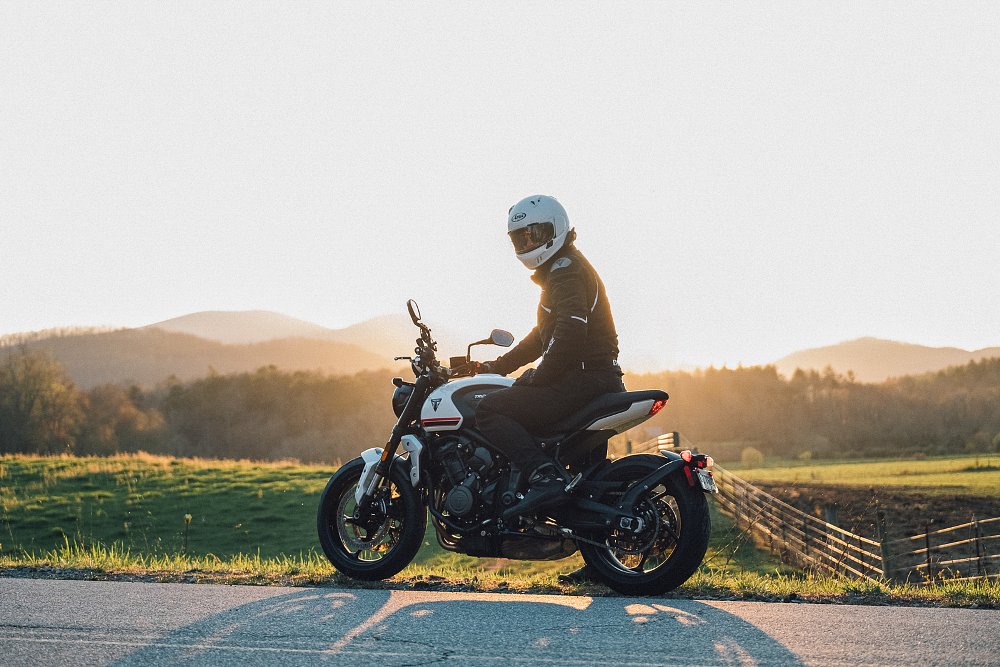
Weather in Georgia can be hit or miss in the springtime. While I was able to avoid thunderstorms, temperatures were in the low 30s for the mornings with highs in the low 60s up in the mountains. This wouldn’t have been a big deal if I hadn’t opted for mesh gear. As I’m typing this, my face is still pretty windburned and chapped and I can only imagine all of the things Lance will have to say about my gear selection in the comments below.
But a little windburn is a small price to pay for a few days of riding some of my favorite roads on the East Coast.
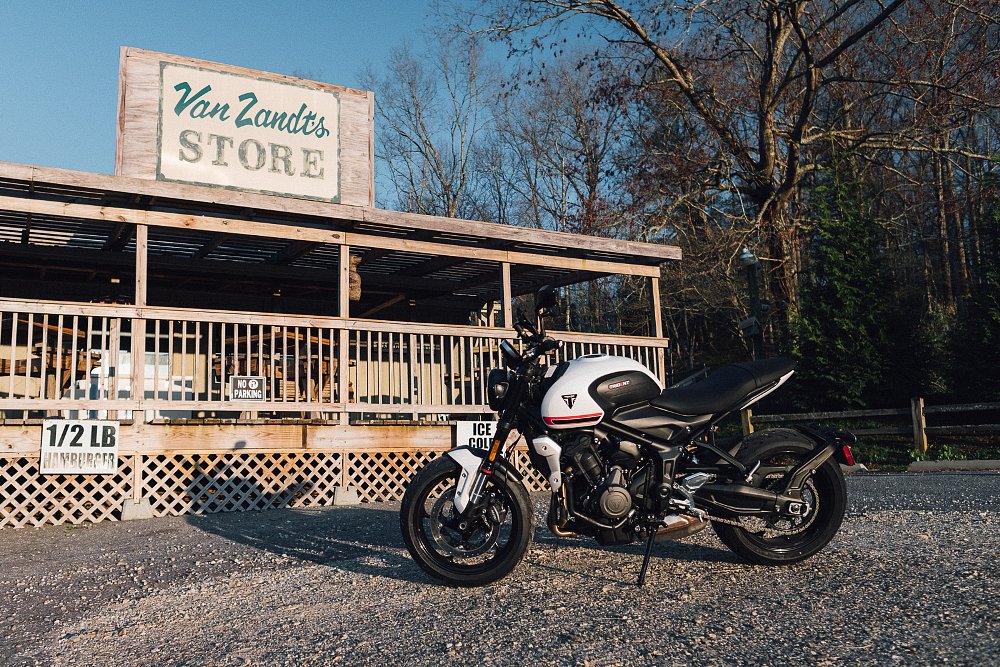
Competition
As I mentioned earlier, the MSRP of the Trident is $8,095. And Triumph packs a lot of standard features into that price. With this bike, they’re clearly going after the increasingly popular middleweight crowd of naked sport bikes.
Off the top of my head, Triumph’s competing with bikes like the Yamaha MT-07 ($7,699), Suzuki SV650 ($7,499), Honda CB650R ($9,199), Kawasaki Z650 ABS ($7,749), and the BMW F 900 R ($8,995). Last year I would have included a Ducati Monster 797 in that mix, but it appears that bike has been dropped from the lineup. The smallest Monster in the Italian manufacturer’s current lineup is powered with a 937 cc L-twin and has a starting MSRP of nearly $12,000.
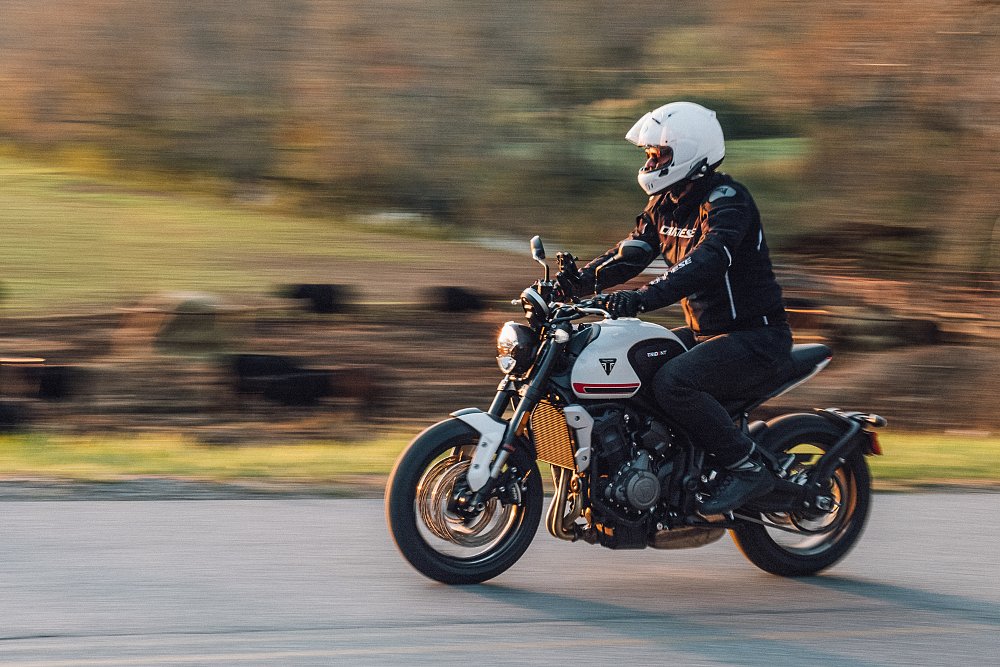
Of all of these bikes, there are plenty of pros and cons to each model, and in a lot of areas the Trident splits the middle of the pack fairly well. But the Trident is the only one in the bunch that brings the uniquely fun character of a triple engine to the segment. And for all of that character, it never feels like it’s going to get away from you. This makes it an ideal option for folks looking at moving up the displacement chain into perhaps their second bike.
Conclusion
All that being said, this Trident most reminds me of the original Street Triple. As the Street Triple evolved into a more aggressive naked sport bike, it lost some of its approachable nature. It got more powerful, more technical, and more expensive. And for folks looking for a great naked sport bike, capable of more aggressive rides and the occasional track day, it’s still one of my favorite picks. But that’s not what the original Street Triple was intended to be.
In the Trident, Triumph has created an awesome middleweight contender that harkens back to what originally made the Street Triple so special. It’s a winner for folks looking for a fun, capable all-around bike for commuting around town or tackling the occasional weekend ride.
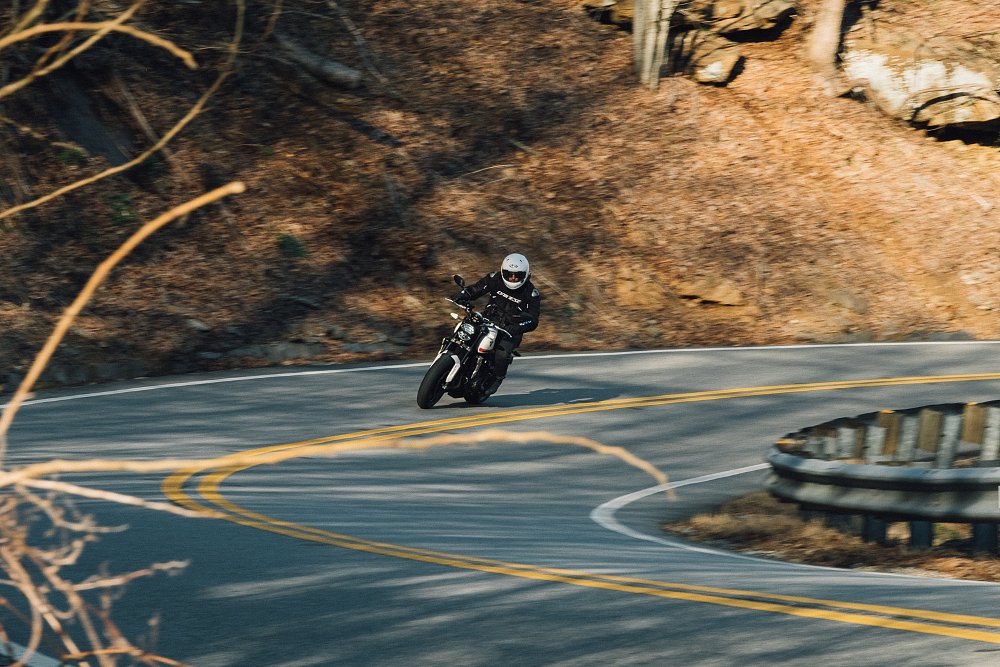
And if you find yourself with the chance to take one for a ride through the mountains of north Georgia or North Carolina, I’d definitely recommend you partake in the experience.
|
2021 Triumph Trident
|
|
|---|---|
|
Price (MSRP)
|
$8,095 (base)
|
|
Engine
|
660 cc, liquid-cooled, DOHC triple
|
|
Transmission,
final drive
|
Six-speed, X-ring chain
|
|
Claimed horsepower
|
80 @ 10,250 rpm
|
|
Claimed torque
|
47 foot-pounds @ 6,250 rpm
|
|
Frame
|
Tubular steel perimeter |
|
Front suspension
|
Showa SFF 41 mm fork; 4.72 inches of travel
|
|
Rear suspension
|
Showa RSU monoshock, adjustable for TK preload; 5.26 inches of travel
|
|
Front brake
|
Dual Nissin two-piston calipers, 310 mm discs, ABS
|
|
Rear brake
|
Nissin single caliper, 225 mm disc, ABS
|
|
Rake, trail
|
24.6 degrees, 4.22 inches
|
|
Wheelbase
|
55.2 inches
|
|
Seat height
|
31.7 inches
|
|
Fuel capacity
|
3.7 gallons
|
|
Tires
|
Michelin Road 5, 120/70R17 front, 180/55R17 rear
|
|
Claimed weight
|
417 pounds (wet)
|
|
Available
|
Now
|
|
Warranty
|
24 months
|
|
More info
|
|





